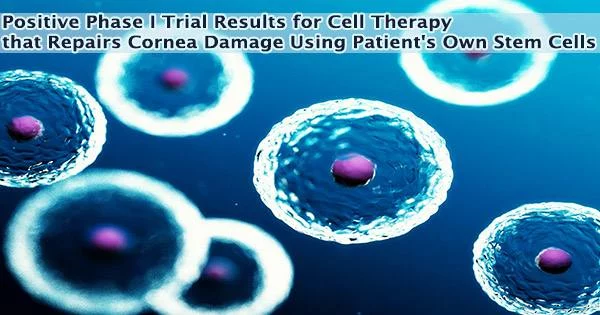Four patients with severe chemical burns to one eye underwent a phase I trial of a novel stem cell therapy called cultivated autologous limbal epithelial cell transplantation (CALEC), which was discovered to be safe and well-tolerated over the short term. The trial was led by researchers from Mass Eye and Ear, a division of Mass General Brigham. The patients who were monitored for 12 months had restored corneal surfaces, two were able to have corneal transplants, and two reported considerable gains in vision without the need for additional therapy, according to the study published on August 18 in Science Advances.
The phase I study was intended to assess preliminary safety and feasibility before moving on to a second phase of the trial, but the early results are encouraging, according to the researchers.
“Our early results suggest that CALEC might offer hope to patients who had been left with untreatable vision loss and pain associated with major cornea injuries,” said principal investigator and lead study author Ula Jurkunas, MD, associate director of the Cornea Service at Mass Eye and Ear and an associate professor of ophthalmology at Harvard Medical School.
“Cornea specialists have been hindered by a lack of treatment options with a high safety profile to help our patients with chemical burns and injuries that render them unable to get an artificial cornea transplant. We are hopeful with further study, CALEC can one day fill this crucially needed treatment gap.”
The Connell and O’Reilly Families Cell Manipulation Core Facility at Dana-Farber Cancer Institute uses a new manufacturing procedure to expand and develop stem cells from a patient’s healthy eye on a graft in CALEC. After two to three weeks, the CALEC graft is sent back to Mass Eye and Ear and transplanted into the eye with corneal damage.
The CALEC project is a collaboration between Jurkunas and colleagues in the Cornea Service at Mass Eye and Ear, researchers at Dana-Farber Cancer Institute, led by Jerome Ritz, MD, Boston Children’s Hospital, led by Myriam Armant, PhD, and the JAEB Center for Health Research. The clinical trial represents the first human study of a stem cell therapy to be funded by the National Eye Institute (NEI), a part of the National Institutes of Health (NIH).
Our early results suggest that CALEC might offer hope to patients who had been left with untreatable vision loss and pain associated with major cornea injuries. Cornea specialists have been hindered by a lack of treatment options with a high safety profile to help our patients with chemical burns and injuries that render them unable to get an artificial cornea transplant. We are hopeful with further study, CALEC can one day fill this crucially needed treatment gap.
Ula Jurkunas
Expanding one’s own stem cells to address limitations in existing treatments
Chemical burns and other eye traumas can cause limbal stem cell deficit, an irreversible loss of cells on the corneal tissue. Permanent vision loss, pain, and discomfort in the afflicted eye are common in these patients. Patients are unable to get artificial corneal transplants, the current gold standard of vision rehabilitation, without limbal cells and a healthy eye surface.
With its novel method of using a small amount of a patient’s own stem cells that can then be grown and expanded to create a sheet of cells that serves as a surface for normal tissue to grow back, the CALEC procedure seeks to address the limitations and risks of existing treatment strategies.
According to the authors, despite landmark studies describing an autologous stem cell approach over the past 25 years and similar methods being utilized in Europe, no U.S. research team had successfully developed a manufacturing process and quality control tests that met U.S. Food and Drug Administration (FDA) requirements or showed any clinical benefit.
“It was challenging to develop a process for creating limbal stem cell grafts that would meet the FDA’s strict regulatory requirements for tissue engineering,” said Ritz, executive director of the Connell and O’Reilly Families Cell Manipulation Core Facility at Dana-Farber and professor of medicine at Harvard Medical School. “Having developed and implemented this process, it was very gratifying to see encouraging clinical outcomes in the first cohort of patients enrolled on this clinical trial.”
Studies like this show the promise of cell therapy for treating incurable conditions. The Gene and Cell Therapy Institute at Mass General Brigham is assisting in the conversion of research findings into first-in-human clinical trials and, ultimately, life-changing therapies for patients.
The Institute stands out from competitors in the field thanks to its multidisciplinary approach, which enables researchers to advance innovative treatments quickly and pushes the clinical and technological limits of this emerging field.
Case studies hold early promise as clinical trial advances
In the phase I study, five patients with chemical burns to one eye were enrolled and biopsied. Four received CALEC; a series of quality control tests determined the cells in the fifth patient were unable to adequately expand. The CALEC patients were tracked for 12 months.
The eye surface defect of the first patient, a 46-year-old male, was resolved, preparing him for an artificial cornea transplant for vision restoration. The second, a 31-year-old male, experienced a complete resolution of symptoms with vision improving from 20/40 to 20/30.
The third, a 36-year-old male, had his corneal defect resolved and his vision improved from hand motion only being able to see broad movements like waving to 20/30 vision. The fourth, a 52-year-old male, initially did not have a successful biopsy that resulted in a viable stem cell graft.
Three years later, he tried CALEC again, and after a successful transplant, his vision improved to the point where he could count fingers instead of just seeing hand motions. He then received an artificial cornea.
The researchers are finalizing the next phase of the clinical trial in 15 CALEC patients they are tracking for 18 months to better determine the procedure’s overall efficacy. They anticipate that CALEC will eventually be a therapy option for patients who previously had to deal with long-term disabilities since the severity of their injuries precluded the use of current treatments.
This study was funded by NEI/NIH grants UG1EY026508 (Massachusetts Eye and Ear), UG1EY027726 (Cell Manipulation Core Facility at Dana-Farber Cancer Institute), UG1EY027725 (Coordinating Center at the Jaeb Center for Health Research). Pre-trial work (Boston Children’s Hospital) was also funded by PACT, an initiative of the NIH’s National Heart, Lung, and Blood Institute.
In addition to Drs. Jurkunas, Ritz, and Armant, additional investigators include Jia Yin, MD, PhD,MPH, Reza Dana, MD, Lynette Johns, OD, Sanming Li, PhD, Ahmad Kheirkhah, MD, Kishore Katikireddy, PhD, Alex Gauthier, PhD, Stephan Ong Tone, MD, PhD and Stacey Ellender, PhD of Mass Eye and Ear, Hélène Negre, PharmD, PhD, Kit L. Shaw, PhD, Diego E. Hernandez Rodriguez, PhD, Heather Daley, BS, of Dana-Farber Cancer Institute, and Allison Ayala, MS, Maureen Maguire, PhD and Lassana Samarakoon, MPH, of Jaeb Center for Health Research.
The CALEC process is still under patent review. Jurkunas and Dana also reveal their ownership of Ocucell, a business looking to provide eye cell therapeutics.
















